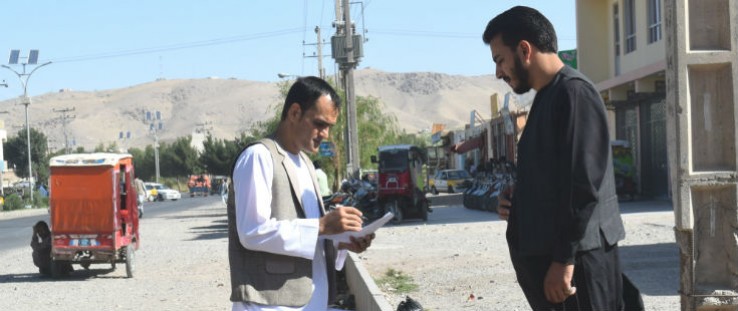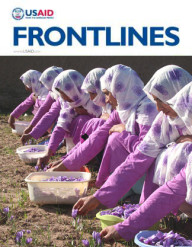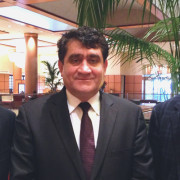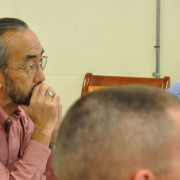 As a USAID project monitor, Sediq Ibrahimi, conducts regular site visits under Tier 1 monitoring, using other monitoring tiers in areas that are harder to reach.
AECOM
As a USAID project monitor, Sediq Ibrahimi, conducts regular site visits under Tier 1 monitoring, using other monitoring tiers in areas that are harder to reach.
AECOM
 As a USAID project monitor, Sediq Ibrahimi, conducts regular site visits under Tier 1 monitoring, using other monitoring tiers in areas that are harder to reach.
AECOM
As a USAID project monitor, Sediq Ibrahimi, conducts regular site visits under Tier 1 monitoring, using other monitoring tiers in areas that are harder to reach.
AECOM
Jawad Ahmadi* worked as a tour guide at the historic Buddha ruins in the mountains of Bamyan province, a region that was a thriving Silk Road hub in earlier centuries. His new career requires a different set of skills: He’s an independent field monitor in western Afghanistan, tracking the progress of multimillion-dollar development projects for USAID.
“I have to be careful to record everything exactly as it really is,” Ahmadi said. “That is my job.”
USAID has worked in challenging environments for decades, creating innovative monitoring methods in places where movement of USAID staffers is restricted by security, poor roads and rugged terrain. Experience has shown that collecting information about projects from multiple sources can help overcome these constraints. In Afghanistan, the Agency has developed a tiered approach to monitoring based on the principle of triangulation: By combining multiple forms of oversight, collected by different actors, a complete picture of a project emerges—from the tiniest flaws to the biggest triumphs.
The multi-tiered monitoring approach combines traditional monitoring methods—visits by the USAID project manager, equipped with a clipboard and checklist—with the help of local communities, other donors, the Government of Afghanistan, new technologies and alternate data-gathering tools to collect and verify information.
Monitoring in Action
The multi-tiered monitoring approach is broken into five time-tested tiers: Tier 1 is hands-on monitoring by USAID or U.S. Government officials. Information gathered by Afghans employed by the U.S. Government is used simultaneously to verify information from the other tiers.
“It's my job to be the eyes and ears on the ground for USAID and to ensure that the money is being spent where it should be,” says Sediq Ibrahimi, a USAID project manager serving as a Tier 1 monitor for a $35 million local governance project. “Through daily site visits, I monitor the construction of drainage canals and sidewalks to make sure things are on schedule and supplies and equipment are not being wasted. The most effective monitoring tool I use to prove that roads, bridges, schools and irrigation canals are being built is my smartphone.”
The Agency also is testing the use of NASA satellite imagery, particularly for infrastructure and agriculture projects, as a way of collecting information on project progress and crop production. Other monitoring tools being considered by the Agency include citizen hot-lines, electronic polling and crowdsourcing, and third-party videos.
“USAID now has the ability to reach out to the field and use cutting-edge monitoring tools to react faster and more successfully to changing environments,” said Timothy Sikes, Program Office deputy director in Afghanistan. “It’s all about creating a knowledge base that contains from-the-site reports, information provided by volunteers and professional monitors, and building in ways to check all that against real-time data sources.”
Under Tier 2 monitoring, implementing partners submit quarterly reports, timelines and site visit reports. They also submit photos that are time- and date-stamped and geotagged as verification that project activities are being completed.
Under Tier 3, the Agency tracks projects through feedback from the USAID network of partnerships with the Government of Afghanistan and international donors also working in the same sector or region. This monitoring combines Afghan Government analyses, coordination meetings with donors, and field reports from trusted partners like the United Nations and the World Bank as another layer of verification.
Tier 4 involves reaching out to Afghanistan’s growing local civil society organizations, such as special interest or public action groups, who often are citizens personally interested in a project’s progress. The actual project beneficiaries are a valuable source of information as well. Multi-tiered monitoring collects and analyzes everything from NGO statements, local news articles, questionnaires, surveys, polls, and even letters or texts from Afghan citizens.
USAID/Afghanistan kicked off its pilot independent monitoring activity in April 2014, in Afghanistan’s western region, deploying monitors equipped with GPS-enabled smartphones. The pilot ran successfully through August, and now the mission has expanded the approach to the country’s southern and eastern regions.
Tier 5 monitoring is an essential part of USAID’s multi-layered approach that uses independently hired monitoring firms to verify and evaluate project activities. In early 2015, USAID will start a five-year independent monitoring support project that will cover all of Afghanistan and more than 100 major projects USAID expects to have in progress over this period.
For Ahmadi, that will almost certainly mean more legwork. These days he is one of a group of monitors charged to inspect 500 USAID-supported health clinics across the country, talking with doctors and midwives, counting the number of staff, and even taking notes about the state of the clinic’s walls.
Ahmadi underscores the importance of his job: “These projects cost a lot of money and they trust me to be accurate,” he says.
*Name changed to protect identity.
Deducing the Multi-Tiered Monitoring Approach
In the absence of Sherlockian powers of deduction, USAID has created a five-tier system to monitor projects:
Tier 1: Hands-on monitoring by USAID or U.S. Government officials
Tier 2: Required reporting by implementing partners on project progress
Tier 3: Feedback from the USAID network of partnerships with the Government of Afghanistan and international donors also involved in a project or working in the same sector or region
Tier 4: Reaching out to Afghanistan’s growing local civil society organizations, such as special interest or public action groups, whose members often are citizens personally interested in a project’s progress as well as project beneficiaries
Tier 5: Independent “third-party” monitors who provide additional, site-specific verification of project activities












Comment
Make a general inquiry or suggest an improvement.